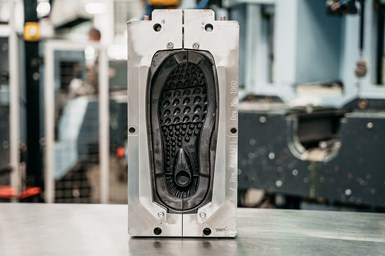Stratasys, ECCO Partner to Innovate Footwear Manufacturing Using 3D Printing Technology
Stratasys Origin One 3D printers and custom materials from Henkel Loctite are said to lower costs and shorten mold fabrication time.
Share
Read Next

ECCO accelerates product development by using Stratasys Origin One 3D printers and materials by Henkel Loctite in its shoemaking development process. Photo Credit: Business Wire
Danish shoe manufacturer ECCO is using Stratasys Origin One 3D printing technology to accelerate product development. This enables conceptual footwear samples to be reviewed early in the development cycle using 3D printed molds and lasts (mechanical forms shaped like a foot) with resin materials from Henkel Loctite.
According to the company, shoemaking can be an incredibly manual process, but ECCO has worked to integrate innovative technologies into its shoemaking, thereby enabling increased automation and a more streamlined development process. One such innovation is the direct injection process (DIP), which has given ECCO numerous benefits, including an efficient and reliable method of securing the upper part of the shoe to the midsole.
To help further innovate shoemaking and the DIP, ECCO turned to additive manufacturing (AM) with the Origin One 3D printer using Stratasys’ P3 technology. ECCO is using the printers in its Portugal and Denmark development facilities to 3D print molds and shoe lasts for development purposes that match the quality requirements of their CNC-machined aluminum counterparts. The molds and lasts, printed from a photopolymer from Henkel Loctite, are faster to produce and the new process costs significantly less than CNC machining aluminum.
“Our innovative approach to footwear development and desire to put customer experience as a priority made additive manufacturing a logical next step in the evolution of our development process,” says Jakob Møller Hansen, ECCO vice president of research and development. “In our search to find the right partner, we tested a variety of 3D printers for surface quality, print speed and accuracy. Among the printers we tested, the Stratasys Origin One was the 3D printer that best met our stringent requirements.”
ECCO's case is a great example of how the footwear industry is embracing AM for functional shoe parts, which goes beyond typical applications such as sport shoe cushioning, according to Chris Prucha, CTO of Production P3 for Stratasys and a co-founder of Origin. “We were able to collaborate with ECCO to provide a solution that allowed them to further innovate their processes and produce a quicker development workflow,” Prucha says.
Related Content
-
3D Printing with Plastic Pellets – What You Need to Know
A few 3D printers today are capable of working directly with resin pellets for feedstock. That brings extreme flexibility in material options, but also requires greater knowledge of how to best process any given resin. Here’s how FGF machine maker JuggerBot 3D addresses both the printing technology and the process know-how.
-
Concept Sneaker Boasts One-Piece 3D Printed TPU Construction
The Reebok x Botter Concept Sneaker Engineered by HP premiered at Paris Fashion Week, hinting at manufacturing possibilities for the future of footwear.
-
Understanding PEKK and PEEK for 3D Printing: The Cool Parts Show Bonus
Both materials offer properties desirable for medical implants, among other applications. In this bonus episode, hear more from Oxford Performance Materials and Curiteva about how these companies are applying PEKK and PEEK, respectively.














